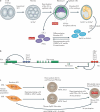Progress in understanding reprogramming to the induced pluripotent state
- PMID: 21415849
- PMCID: PMC3273493
- DOI: 10.1038/nrg2955
Progress in understanding reprogramming to the induced pluripotent state
Abstract
Induction of pluripotency by transcription factors has become a commonplace method to produce pluripotent stem cells. Great strides have been made in our understanding of the mechanism by which this occurs--particularly in terms of transcriptional and chromatin-based events--yet only a small part of the complete picture has been revealed. Understanding the mechanism of reprogramming to pluripotency will have important implications for improving the efficiency and quality of reprogramming and advancing therapeutic application of induced pluripotent stem cells. It will also help to reveal the machinery that stabilizes cell identity and to instruct the design of directed differentiation or lineage switching strategies. To inform the next phase in understanding reprogramming, we review the latest findings, highlight ongoing debates and outline future challenges.
Figures



References
-
- Takahashi K, Yamanaka S. Induction of pluripotent stem cells from mouse embryonic and adult fibroblast cultures by defined factors. Cell. 2006;126:663–676. - PubMed
-
First demonstration that expression of four pluripotency-related transcription factors can convert somatic cells to a pluripotent state, now known as iPSC, which has been a major breakthrough in stem cell biology.
-
- Maherali N, et al. Directly reprogrammed fibroblasts show global epigenetic remodeling and widespread tissue contribution. Cell Stem Cell. 2007;1:55–70. - PubMed
-
First characterization of X chromosome inactivation status in iPSC reprogramming demonstrating that mouse iPSCs are XaXa and can undergo random X-inactivation indicating complete erasure of the memory of the prior inactive X.
Publication types
MeSH terms
Substances
Grants and funding
LinkOut - more resources
Full Text Sources
Other Literature Sources

